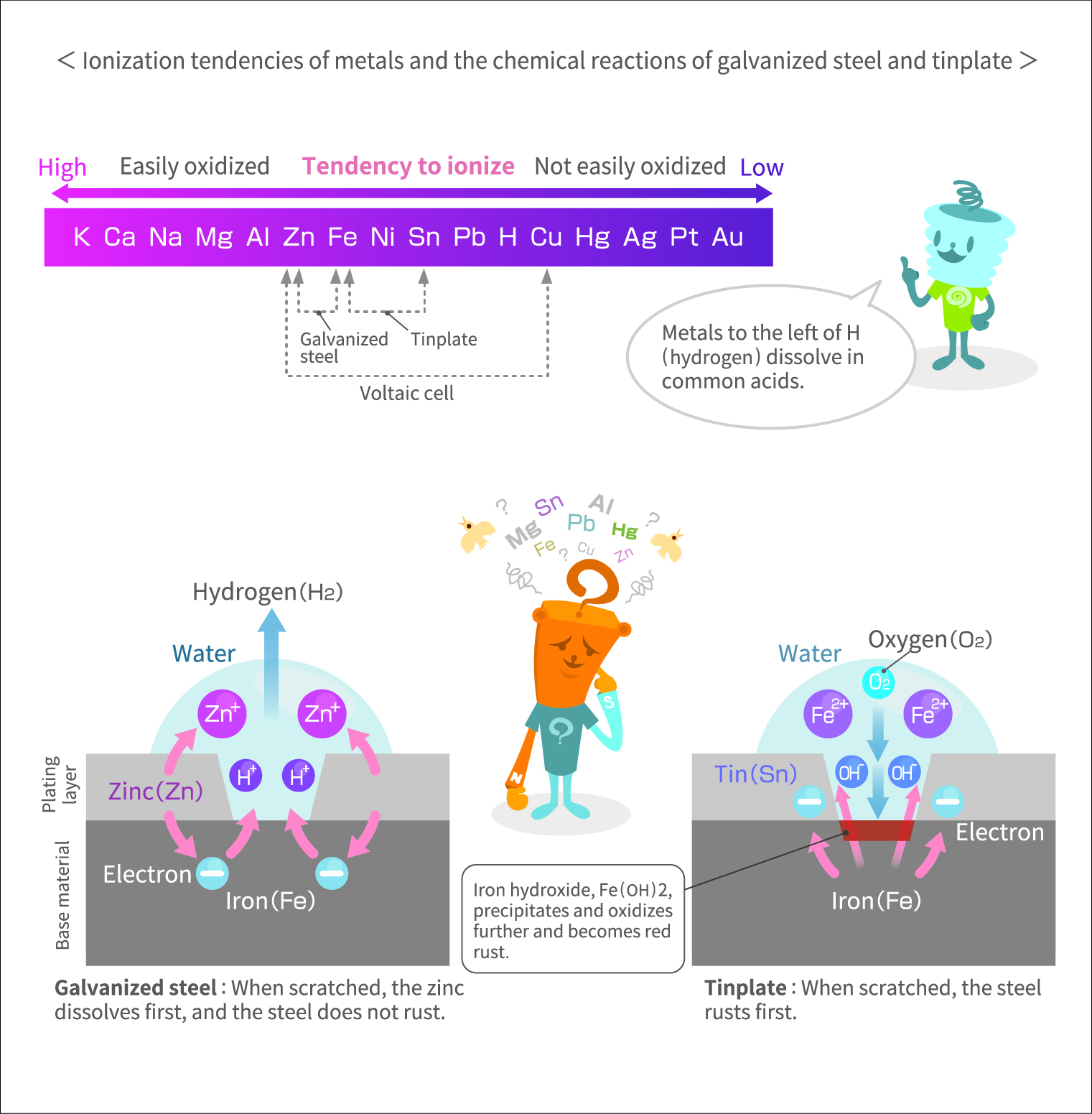The Wonders of Electromagnetism
What is Resonance Phenomenon? Mechanism of tuning circuits.

Sound waves are air vibrations, radio waves are electromagnetic field vibrations, and seismic waves are earth vibrations. Everything has a natural frequency, and when it matches an external vibration period, it resonates and its amplitude increases significantly. Although the phenomenon of resonance can cause some complicated problems, it plays an extremely important role in musical instruments, machinery, electrical and electronic circuits, and especially in radio equipment that uses radio waves.
What is resonance?
First of all, we will explain natural vibration, which is largely related to resonance. When an impact is applied to an object, the object vibrates at a specific frequency (number of waves per second). This is the natural vibration, and this frequency is called the natural frequency. Since the natural frequency is determined for each object, no matter what kind of impact is applied, the object vibrates at its natural frequency.
Then, what is resonance? When an object is subjected to an external vibration of the same frequency as the object's natural frequency, the stationary object begins to vibrate. This is resonance. If a vibration of the same frequency as the natural frequency of an object is repeatedly applied from the outside, the amplitude increases and the vibration becomes larger and larger. This phenomenon of vibrating much larger than the applied force is also resonance.
Energy transfer by resonance of a coupled pendulum
A coupled pendulum is a vibrating system in which two or more pendulums influence each other. Two pendulums (pendulums A and B) of equal thread length and weight are suspended from a wire stretched horizontally. When only pendulum A is made to vibrate, pendulum B, which had been stationary, begins to vibrate. Pendulum A gradually decays and eventually stops. At this time, the amplitude of pendulum B is at its maximum. Next, the stationary pendulum A starts to oscillate again, and pendulum B gradually decays and eventually stops.
Pendulum A and B, which have equal lengths of thread, have the same natural frequency of vibration, so resonance occurs, and it transfers energy in this way.
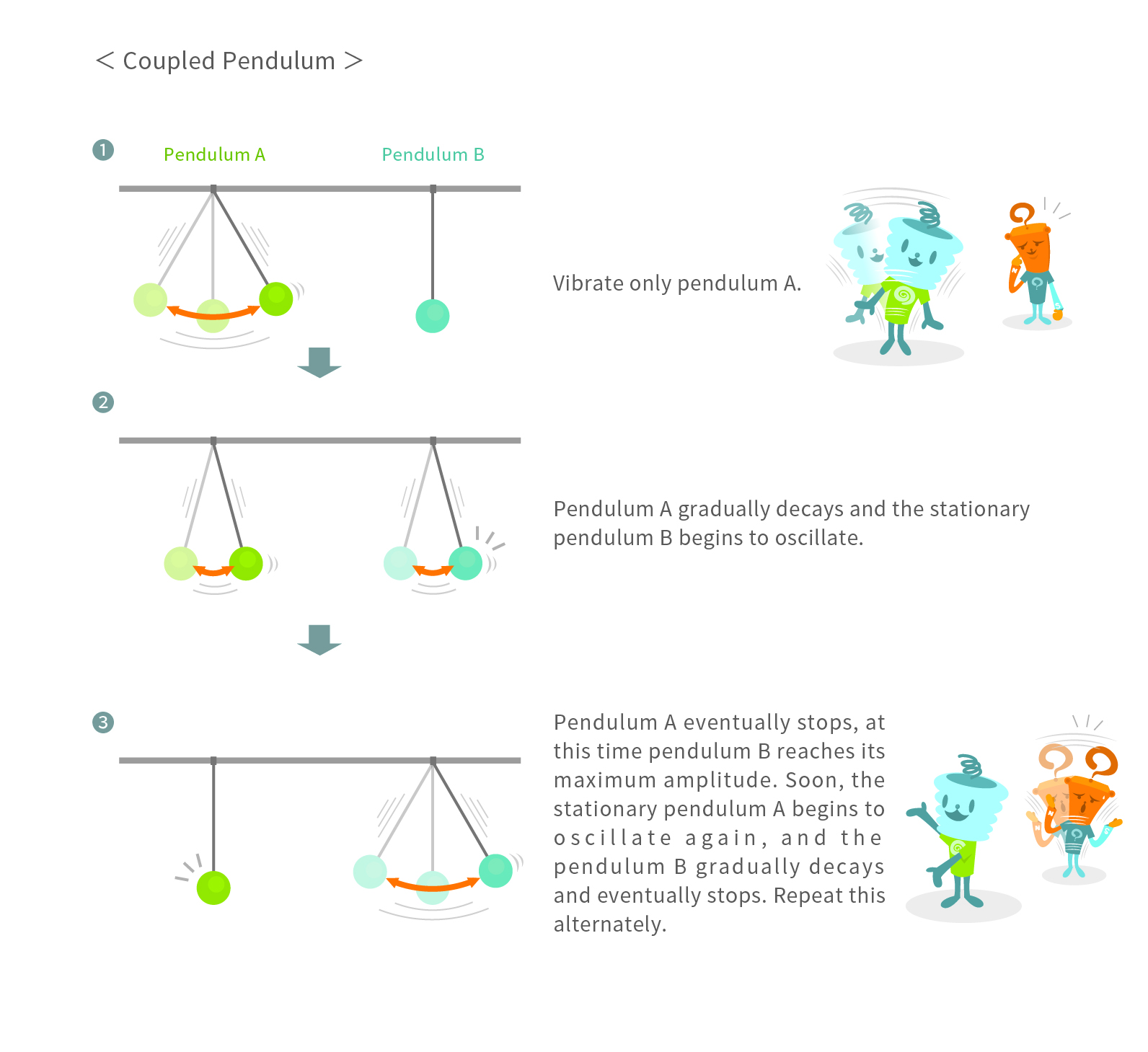
The natural world is full of resonance phenomena
There is a musical instrument called a glass harp. However, it is not a harp made of glass.
It is an instrument that is not unlike a musical instrument in that you rub the rim of a stemmed glass, such as a wine or brandy glass, with your finger, and the frictional vibration produces a continuous "hum" sound. By adjusting the amount of water in the glass, it is possible to create a scale of "C, D, E, F, ...", so that many glasses can be arranged in a row to play melodies and chords. The more water you put in the glass, the lower the sound it produces. The sound is related not only to the vibration of the glass but also to the vibration of the water.
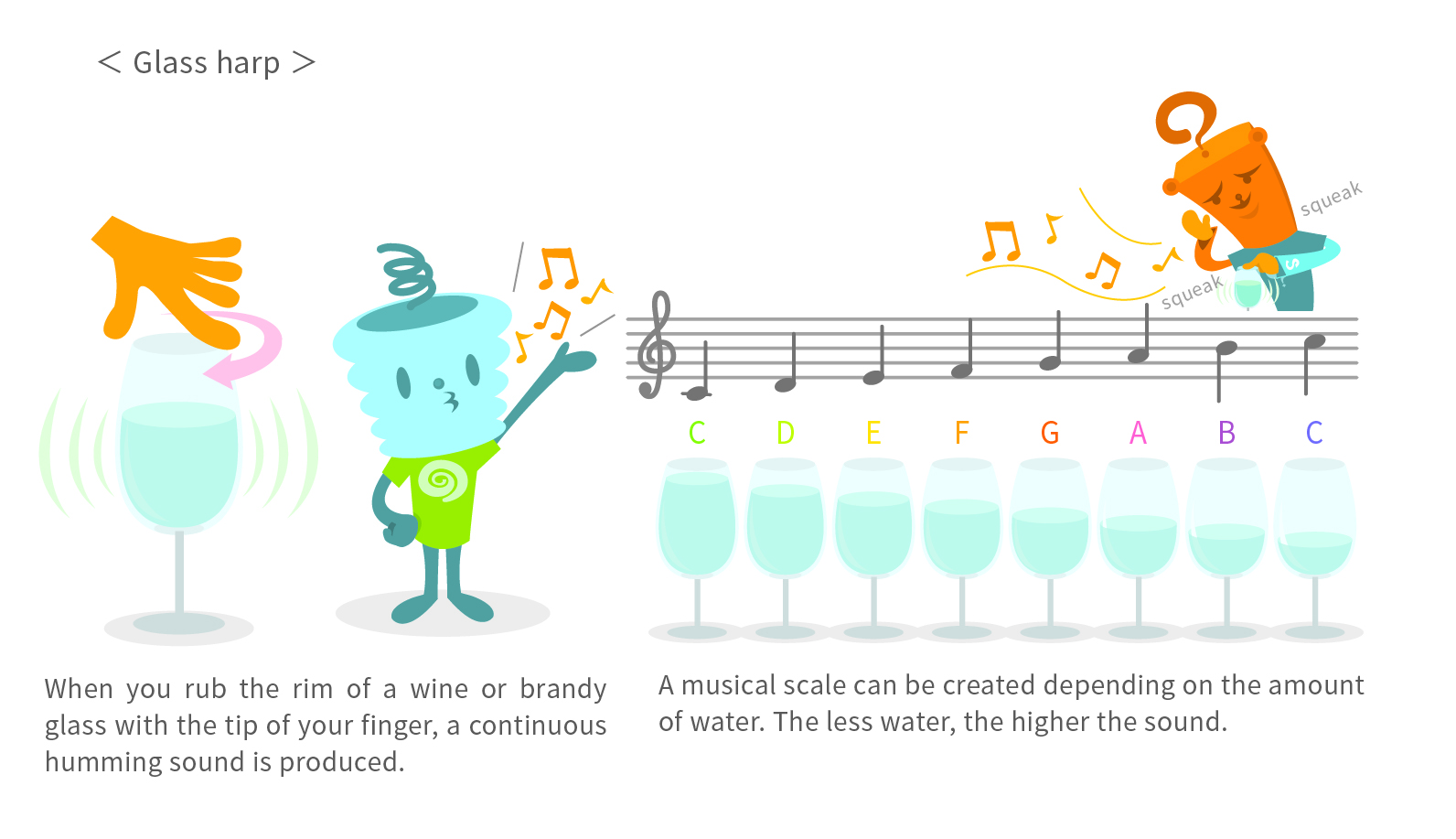
The "Resonance Pan" is an ancient Chinese tool similar in principle to the glass harp. In appearance, the copper tray looks like a wok with two handles. When filled with water and the handles are rubbed quickly and continuously with the palms of both hands, the copper pot emits a buzzing sound and the water begins to vibrate, and eventually, a splash erupts from the surface of the water.
The trick to make a high splash is to fill it with the right amount of water and to rub the handle with your hand. For expert operators, the splash height is said to reach nearly one meter.
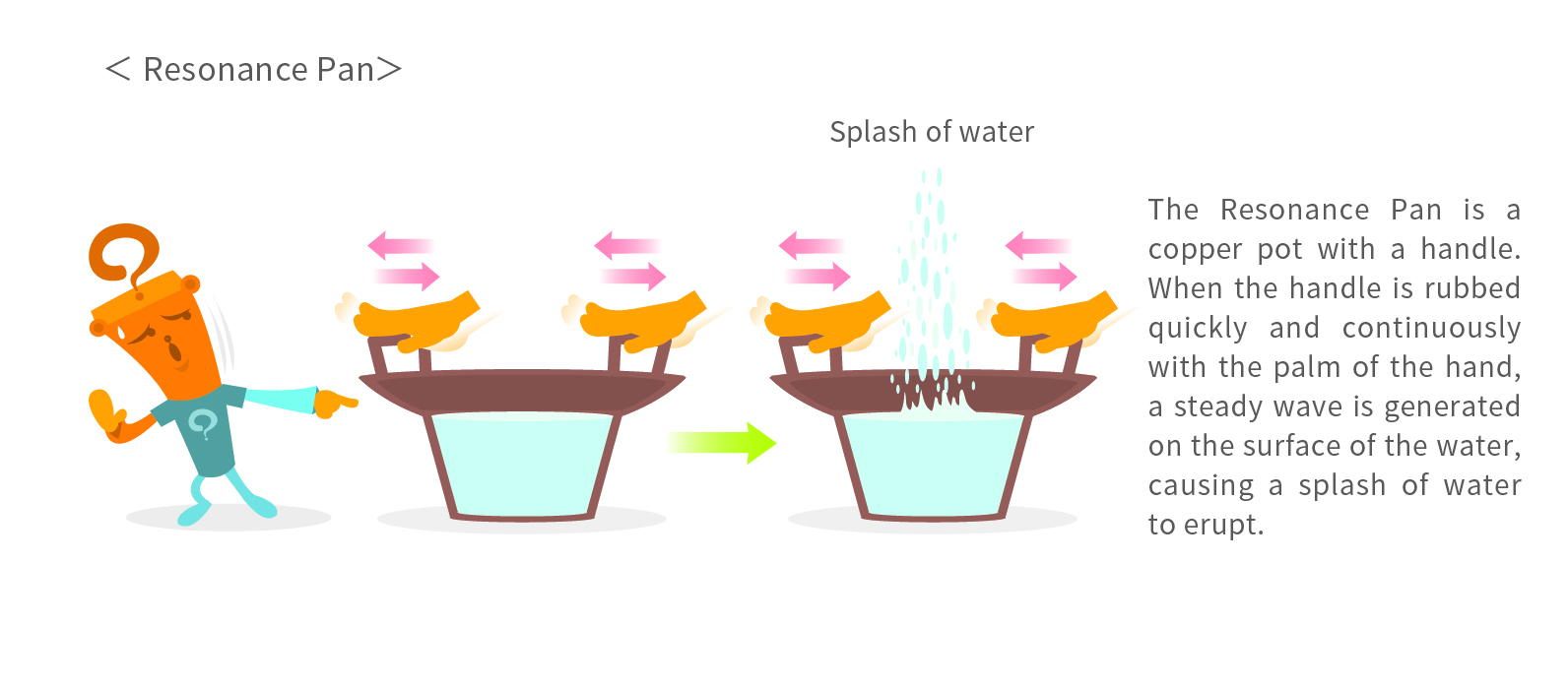
Water spurts up against gravity because the natural frequency of the water in the copper basin matches the period of frictional vibration, causing a resonance phenomenon that results in a standing wave of water vibration. A standing wave is a vibration whose waveform does not change. A guitar string with both ends fixed produces a constant sound because a standing wave is generated with both ends as nodes of the wave (in reality, it also includes integer multiples of harmonics). Since the stationary wave has a constant waveform, the energy supplied is devoted to increasing its amplitude. In the Resonance Pan, the energy supplied by the friction of the human hand causes an increase in the amplitude of the stationary wave, which in turn causes a splash of water.
Resonance is also a phenomenon that transfers energy to a remote location. For example, when you ring a tuning fork in a resonance box, it will ring a tuning fork in another resonance box of the same size, located at a distance. Not only in these science experiments, the natural world is full of resonance phenomena.
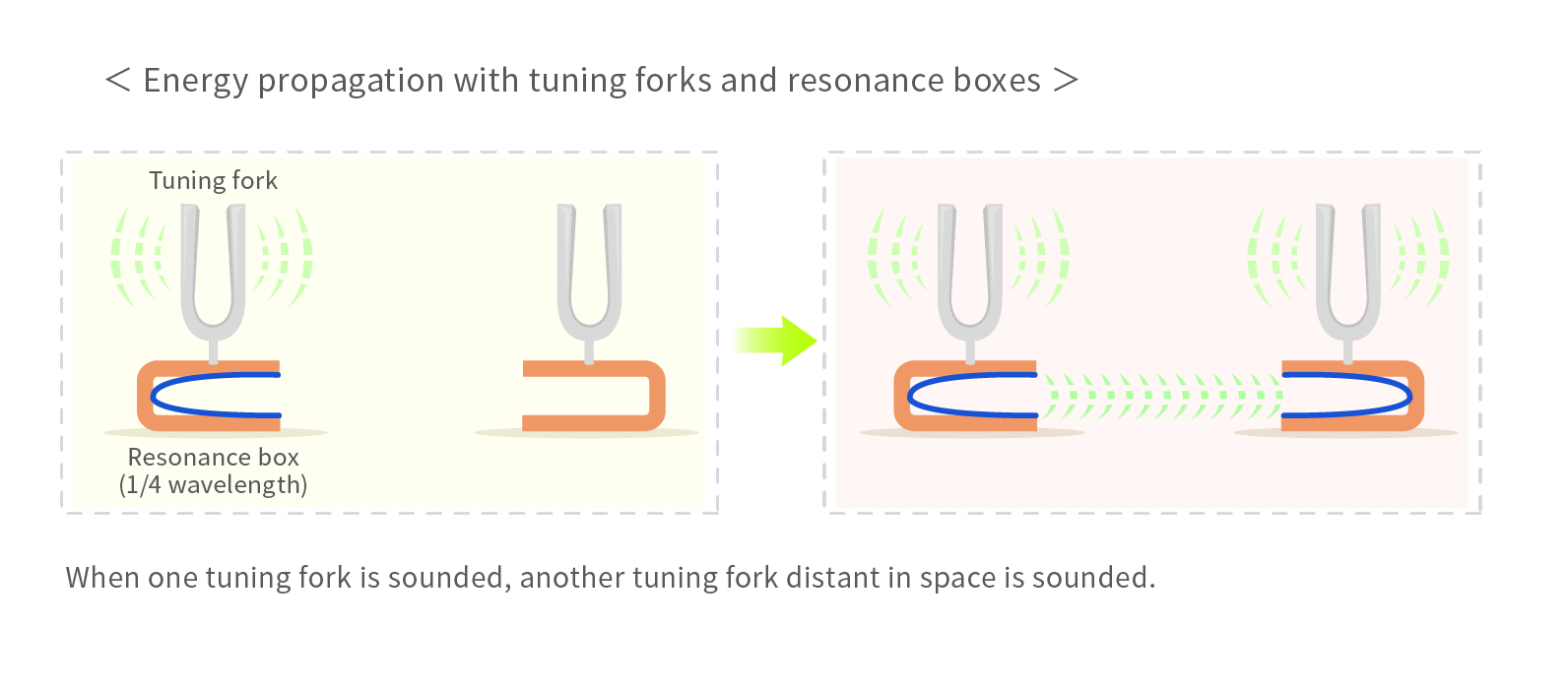
Resonance is also used in tuned circuits
Resonance is also used in the tuning circuits of radio equipment such as radios, televisions, and cellular phones.
Capacitors and coils, which together with resistors are the three major passive electronic components, exhibit opposite characteristics towards electric current. A capacitor with two electrodes facing each other across an insulator does not conduct direct current, but conducts alternating current, and the higher the frequency of the alternating current, the smaller the reactance (resistance in alternating current) becomes, making it easier to conduct alternating current.
On the other hand, a coil flows low-frequency alternating current smoothly like direct current, but as the frequency increases, the reactance increases and the flow becomes more difficult.
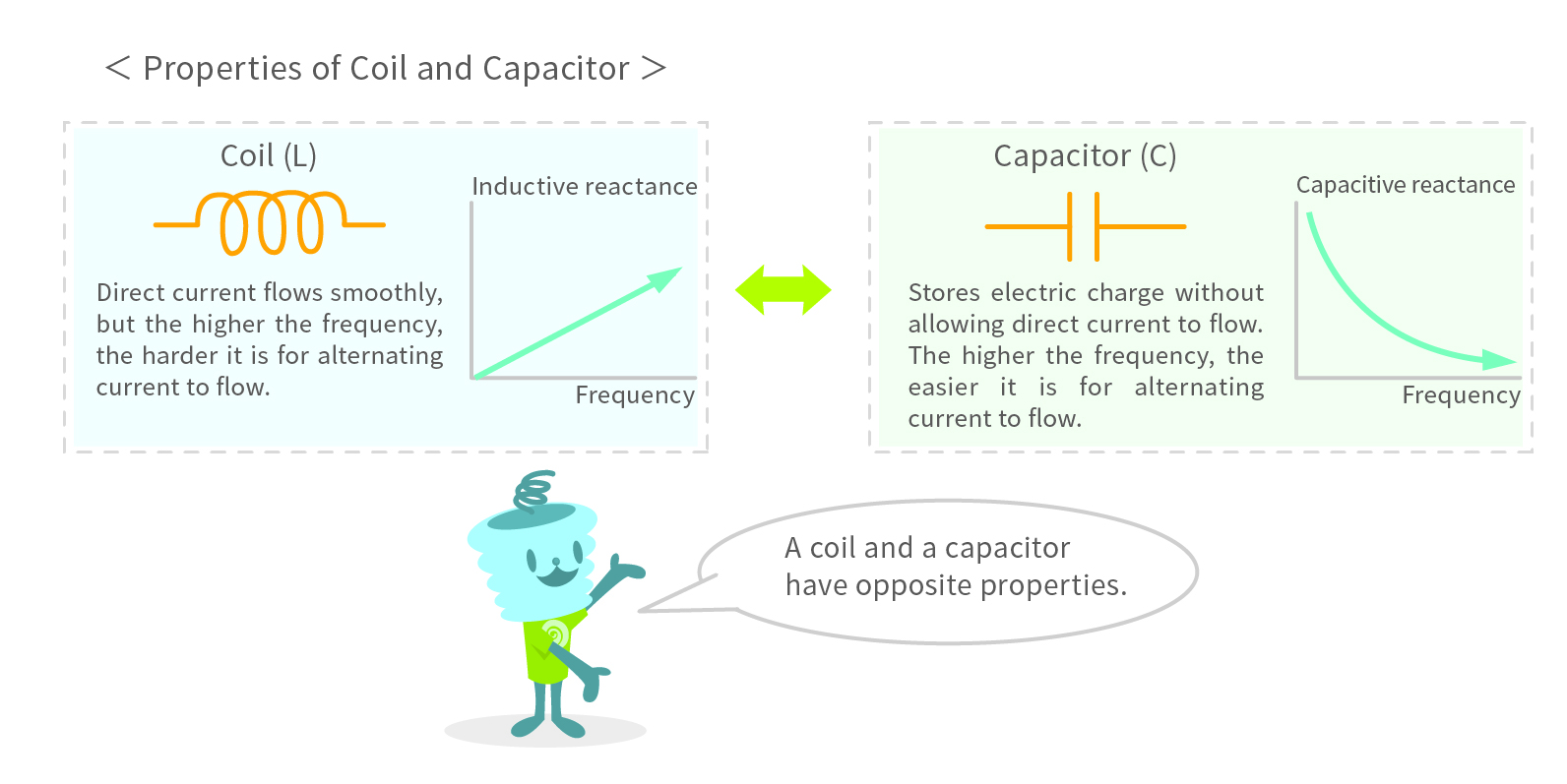
The combination of a capacitor and a coil with these opposing properties creates a tuned circuit that selects radio waves of a certain frequency. Ore radios are ideal for understanding tuned circuits.
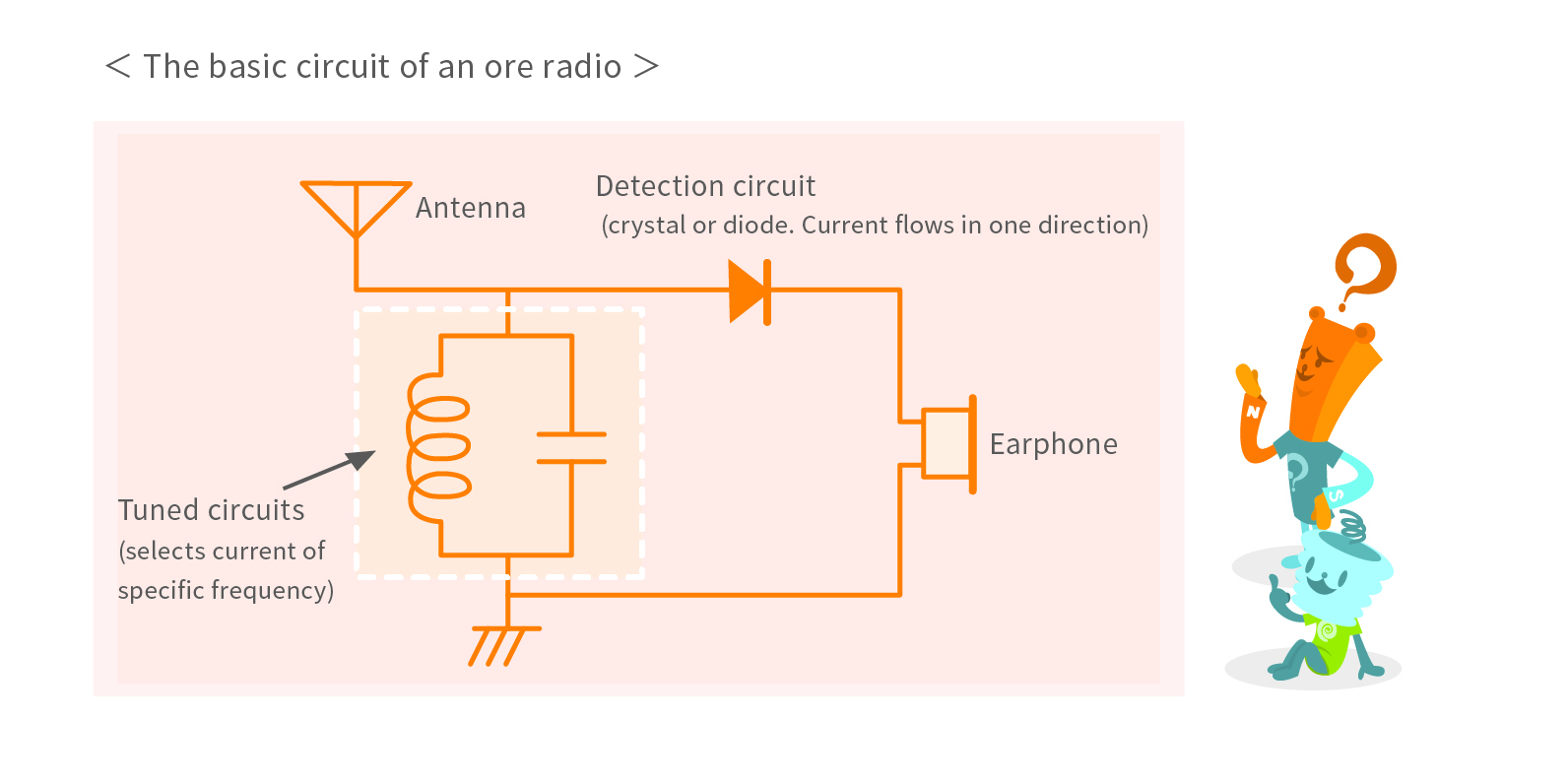
A crystal radio is a receiver that uses mineral crystals as part of its circuit and uses the weak frequency radio energy picked up from the antenna as it is to make earphones sound.
Specifically, the antenna of a crystal radio captures radio waves of various frequencies, and an alternating current in a certain direction is passed through the detection circuit (crystal or diode).
However, this does not select signals of specific frequencies, and you cannot listen to the stations you want to listen to.
Thus, in parallel or in series with the circuit, insert a tuned circuit that combines a capacitor and a coil. This allows you to listen to your favorite broadcast station by extracting a specific frequency.
Here, we will explain the mechanism using a parallel-type tuned circuit as an example. (*Refer to Figure: How tuned circuits work (parallel type))
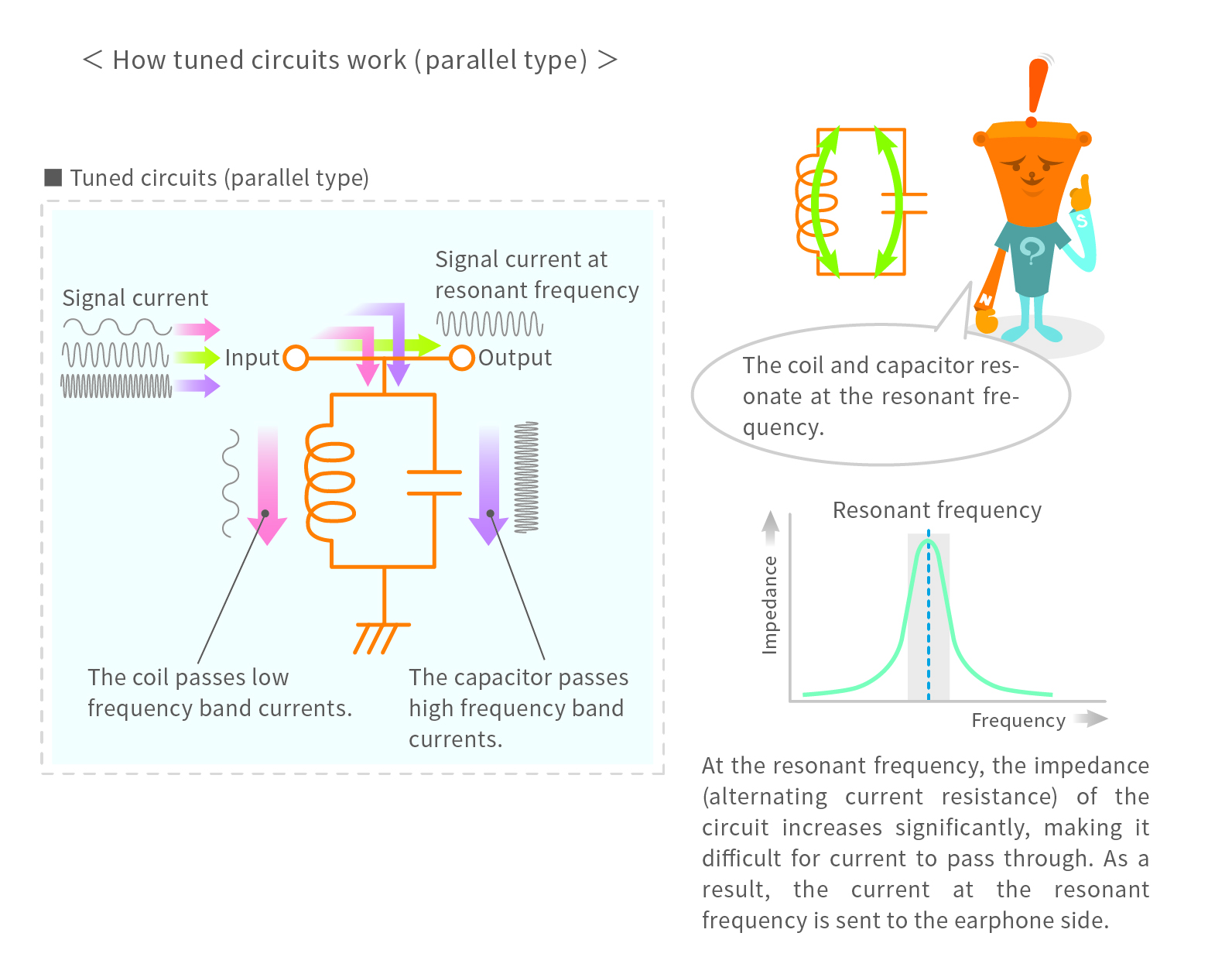
Capacitors and coils have opposite impedance (AC current flow resistance) with respect to frequency. In a tuned circuit, a capacitor releases high-frequency AC to the ground side. While the coil releases low-frequency alternating current to the ground side. On the other hand, when these two are placed in parallel, the impedance (resistance) of the intermediate frequency, which is difficult for each to release, becomes large.
This is the resonance phenomenon, and at the frequency at the top of this increased peak (resonance frequency), the impedance is extremely high, so the alternating current flows to the earphone (output) side instead of the ground side. In other words, only the alternating current of the resonance frequency, i.e., the specific frequency, passes through to the earphone side, allowing you to listen to the broadcast station you want to listen to. This is the basic principle of tuned circuits.
The inventor of the tuned circuit was Sir Oliver Joseph Lodge (1898) of England, who was also the inventor of the coherer detector. It was a revolutionary idea, because early radio communications used radio waves emitted from high-voltage spark discharges, which contained various frequency components and would cause interference if the number of radio stations increased.
This led to the need for constant frequency communication, and the invention of tuned circuits.
The unlimited development of today's wireless communications, such as cellular phones, wireless LAN, and UWB communications, started with this simple tuned circuit.
Resonance Phenomena and Noise Problems in High-Frequency Circuits
The dials and buttons used to select stations on radios and televisions change their resonant frequencies by changing the constants (capacitance and inductance) of the capacitors and coils in tuned circuits. In principle, tuned circuits are the same as LC filters (low-pass filters, high-pass filters, and band-pass filters) that pass or block signals in a specific frequency band.
For example, if a coil is inserted in series with a signal line and a capacitor in parallel, the high-frequency signal is bounced back by the coil and routed to the ground by the capacitor, thus becoming a low-pass filter that allows only the signal current to pass through.
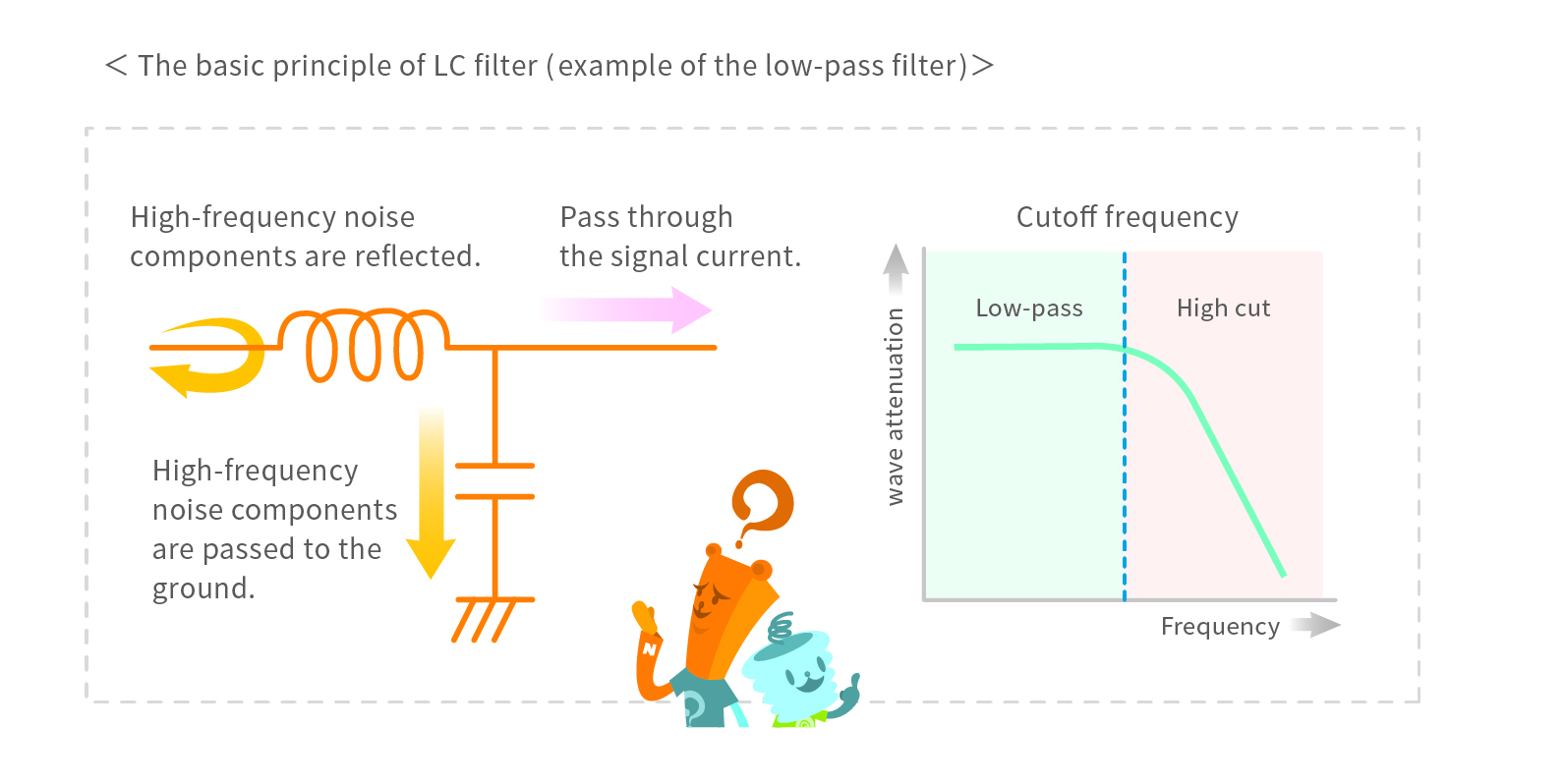
LC filters are also used as noise filters to eliminate noise in the high-frequency range. However, as the signal frequency increases to megahertz and gigahertz, the frequency range of high-frequency noise becomes closer, so a noise filter must be sharper than an ordinary LC filter (having a sharp attenuation characteristic). Moreover, in high-frequency circuits, there are resonance phenomena caused by capacitor (capacitance) and coil (inductance) components that do not appear in the circuit diagram, causing various troublesome problems.
For example, even a slight curve in wiring has a coil component, and the capacitance between the wiring and the ground acts as a capacitor. Not only that, but even the leads of electronic components have capacitor and coil components.
This causes resonance phenomena in the high-frequency range, acting like tuned circuits or LC filters, and, for example, causes the shape of a pulsed square wave to collapse or tangle, which can result in signal transmission errors. This frequency is called the self-resonant frequency (SRF).
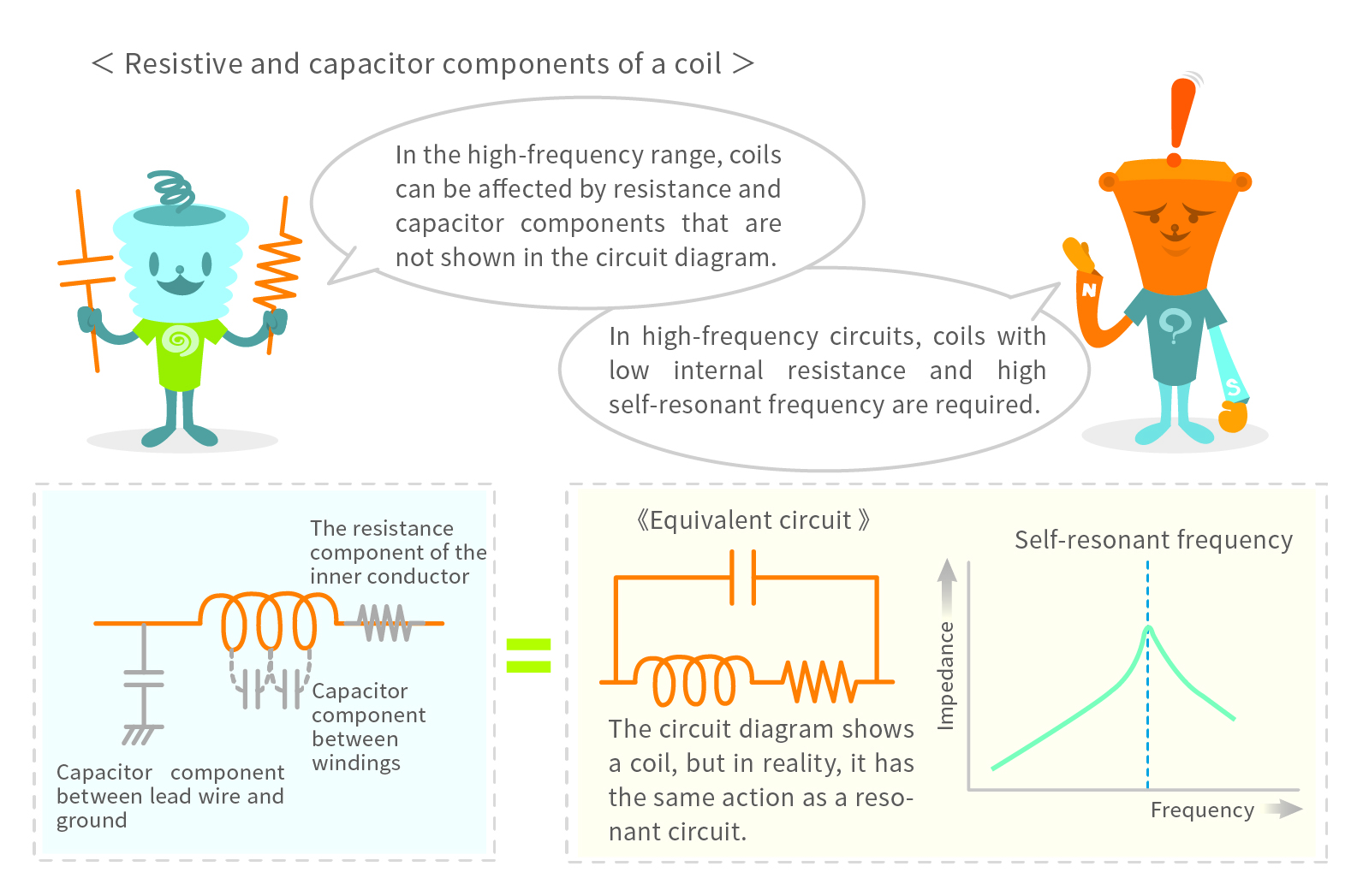
This problem has become more serious since 1970, when digital devices began to appear around us. The faster, more sophisticated, and more multifunctional electronic devices become, the more advanced noise countermeasures are required.
Among these, EMI (Electro Magnetic Interference) countermeasures are required so that the device itself does not become a source of noise, and EMS (Electro Magnetic Susceptibility) countermeasures are required so that the device is not affected by noise even if it is exposed to it. This is called EMC (Electro Magnetic Compatibility).
TDK strongly supports customers' EMC countermeasures by providing optimal EMC countermeasure components, incorporating advanced simulation technology into designs, and providing EMC measurement services in an anechoic chamber.
Resonance is a universal phenomenon in nature. It sometimes causes troublesome problems, but by overcoming these problems and making clever use of them, the electronics society has made great progress. Oscillation circuits using quartz (crystal oscillators), lasers, and magnetic resonance imaging (MRI) devices are also systems that utilize the resonance phenomenon.
TDK is a comprehensive electronic components manufacturer leading the world in magnetic technology



